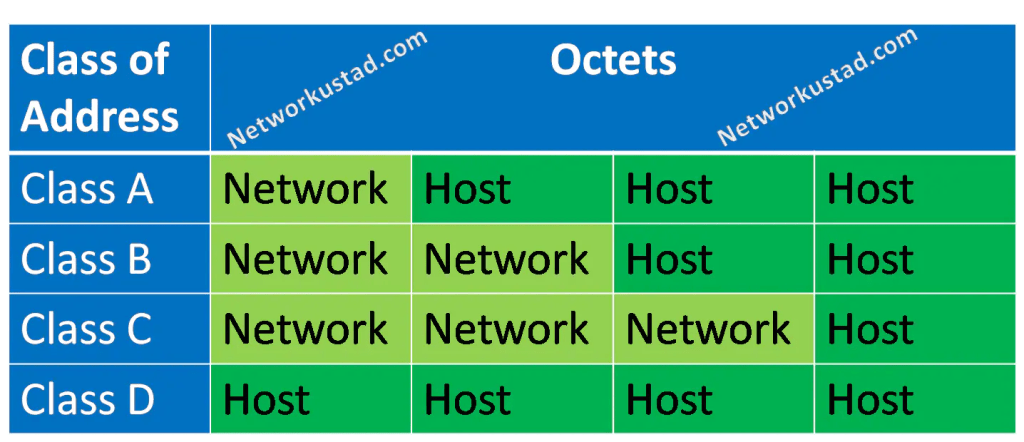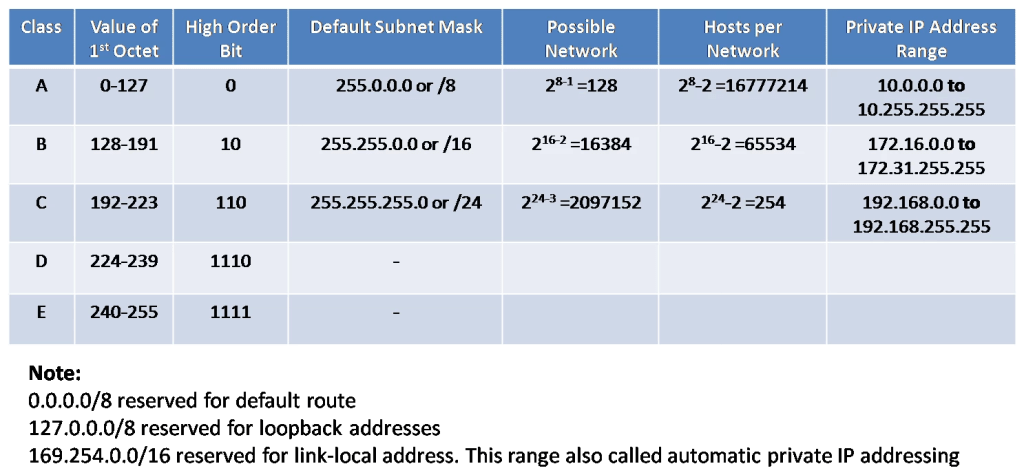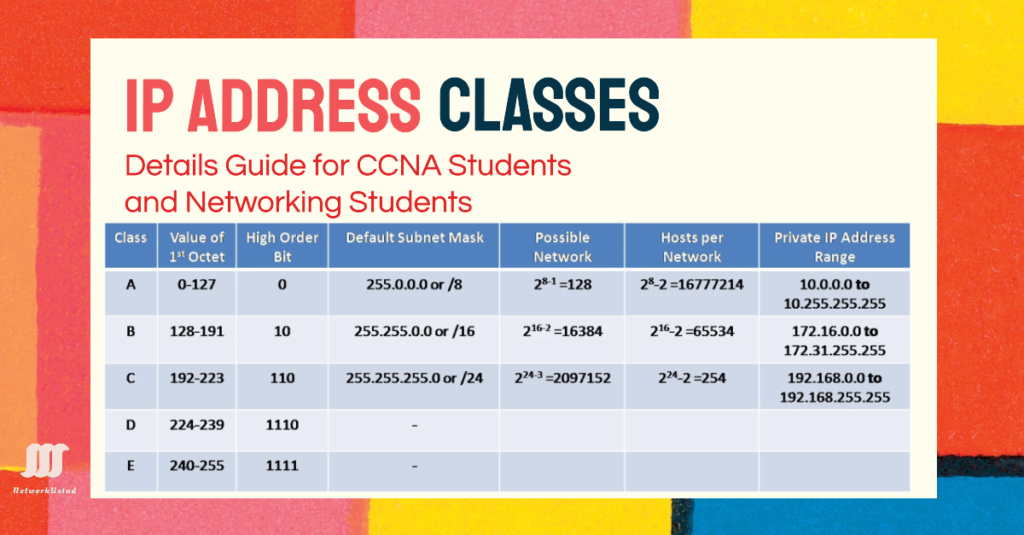Mastering IPv4 Address Classes with Confidence: 2025 Guide
The IPv4 address is an identifying number for network devices. It is similar to a home or business address, which supplies that specific physical location with a particular address. Devices on a network are differentiated from one another through IPv4 addresses. In 2025, understanding IPv4 addressing is critical for CCNA preparation and managing networks with 5G, IoT, and high-speed 400G/800G interfaces, where address scalability remains a key challenge.
An IPv4 address allows a device to communicate with other devices over an IP-based network, like the Internet. There are two primary standards for IPv4 addresses: IPv4 and IPv6. In this article, I will discuss the IPv4 address. The IPv6 address will be discussed in later articles.
IPv4 Addressing
IPv4 is the fourth revision of IP and a widely used protocol for data communication over various networks. It is defined and specified in the IETF publication RFC 791. A connectionless protocol provides logical connections between network devices and a unique identification for each device.
Depending on the network type, we can configure the IPv4 addresses on the network devices manually or automatically. IPv4 uses 32-bit addresses for Ethernet communication in five IPv4 address classes: A, B, C, D, and E.
As of 2025, IPv4 address exhaustion drives the adoption of NAT and IPv6 transition strategies, especially in data centers supporting 100G/400G backbones.
Address Architecture
TCP/IP was introduced in the 1980s. At that time, the Internet used a two-level addressing scheme, which offered sufficient scalability. The 32-bit IPv4 address, introduced in the 1980s with a two-level scheme, now uses subnetting and CIDR in 2025 to support modern 400G/800G networks and IoT scalability. The figure below illustrates the 32-bit address architecture in the 1980s.

The current IPv4 address is also 32 bits long and contains two portions: a network and a host portion. The network portion identifies the host’s network, and the host portion shows the host’s number in the network. The host portion identifies the device or the host. The router uses the network portion of the IPv4 addresses to make routing decisions and to facilitate communication between hosts that belong to different networks. Like routers and computers, humans can’t work with strings of 32 bits (1s and 0s).
Therefore, we express the 32-bit IPv4 address in dotted-decimal notation, as we know that 32-bit addresses are further divided into four groups of eight, called octets. An octet ranges from 000000000 to 11111111. Each octet is converted to decimal and separated by decimal points or dots. The range of each octet in decimal is from 0 to 255.
For example, 10.10.10.1, 172.16.16.254, and 192.168.0.254 are IPv4 addresses expressed in dotted decimal notation. If we can convert these addresses to binary. For example, the binary of the above addresses is 00001010. 00001010. 00001010.00000001, 10101100. 00010000.00010000. 11111110, 11000000. 10101000.00000000.11111110.
The 32-bit IPv4 structure is supplemented with subnetting and CIDR to optimize address allocation for dense IoT networks and high-speed 400G/800G deployments.
IPv4 Address Classes
At the start of TCP/IP, the IPv4 address classes define the network and host portions. IPv4 addresses are divided into five different IPv4 address classes. The first few bits of the first octet determine the IPv4 address classes. These bits are known as high-order bits (HOB). Although the IPv4 address classes can still be applied to IPv4 addresses, networks today often ignore the class rules in favor of a classless IP scheme. The five IPv4 address classes are A, B, C, D, and E.
Classes A, B, and C have different bit lengths for addressing the network host. Class D addresses are reserved for multicasting, while Class E addresses are reserved for future use. Depending on the address class, each of the four octets of an IPv4 address represents the network portion of the address. The figure below illustrates the network and host portions of the respective Class A, B, C, and D addresses.

The first three IPv4 address classes, A, B, and C, host addresses in any IP network. However, the Class D addresses are used for multicasting. Class E addresses are reserved for experiments in labs and medical equipment and are not shown in the above figure.
It is not easy to identify the network and host portions of any dotted-decimal IPv4 address because IPv4 addresses are not four numbers. They contain 32 different numbers or 32 bits (0 or 1s). The figure below illustrates all the important figures of IPv4 address classes.

In 2025, classful addressing is largely replaced by classless inter-domain routing (CIDR), enabling efficient IP allocation for 5G and IoT devices across 100G/400G networks.
Class A
The most significant bit of the class A network is 0, also known as the high-order bit(HOB). The remaining seven bits in the first octet define the number of networks in class A addresses, and the three octets (24 bits) define the total number of IPv4 addresses available in the class. The figure below illustrates Class A’s address bit distribution.
If the first bit of an IPv4 address’s first octet is binary 0, the address is a Class A address. With the first bit being 0, the lowest number is 00000000 (decimal 0), and the highest number is 01111111 (decimal 127). Any address that starts with a value between 0 and 127 in the first octet is a Class A address. The numbers 0 and 127 are reserved and cannot be used as a network address.
Class A network can accommodate a very large number of hosts because only the first octet is reserved for the network number. The three octets, or 24 bits, are reserved for the host portion of the network. Each network of this class supports a maximum of 16,777,214 (2^24 -2) hosts per network. Figure 2 is subtracted because the first and last addresses are reserved as network IDs and broadcast IPs. The lowest address is 24, 0s in the host portion, and the highest is 24, 1s in the host portion.

The routing table uses network ID for the routing table. So, an address with all 0s in the host portion cannot be used with the individual host. For example, 10.0.0.0 is a Class A Address containing all 0s in the host portion. So it is network identification and cannot be configured on network hosts and devices.
Every network also requires a broadcast address, which can be used to send a message to each host on the network. This address has all 1s on the host portion. For example, a broadcast address for network 10.0.0.0 would be 10.255.255.255.
The total number of networks in Class A is 126. Each of the 126 Class A networks has almost 17 million host addresses, which make up 50 % of the entire IPv4 address space. The 0.0.0.0 address is also reserved for the default route. 127.0.0.0 is reserved for the local loopback address, which is why the Class A network range is from 1 to 126, and Class B addresses start from the address of 128.0.0.0.
A Class A network provides many possibilities for any organization or company. It is a huge global network with many hosts, and the hosts in such a network do not function as members of the same logical group.
Class A addresses creating a large broadcast domain, but network administrators need smaller logical groupings to control broadcasts, apply policies, and troubleshoot problems. This is possible by applying a subnet mask, which allows subnetting.
Subnetting breaks a large block of addresses into smaller groups called subnetworks. It avoids the waste of IPv4 addresses and is also helpful for better efficiency. The default subnet mask for a class A IPv4 address is 255.0.0.0. The private IPv4 address range for class A is 10.0.0.0 to 10.255.255.255.
Class B
The high-order bit of class B addresses starts with a binary 10 in the first 2 bits of the first octet. So, the lowest number of class B addresses is 10000000 (decimal 128), and the highest is 10111111 (decimal 191). So, any IPv4 address starts with a range between 128 – 191, and the first octet is a class B IPv4 address. A Class B network can provide an addressing scheme to medium-sized networks.
In Class B, the first two octets represent the network, and the other two represent the address’s host portion. So class B has 16384 (214) Network addresses and 65534 (216-2) Host addresses. So, each Class B network can support up to 65,534 hosts. The Class B network is much smaller than the networks of Class A. Just like Class A networks, we can subnet the Class B network to improve network efficiency. The figure below illustrates the 32-bit distribution of the Class B network.

The first octet of a Class B address has 64 possibilities ranging from 128 to 191. The second octet has 256 possibilities ranging from 0 to 255. That gives 16,384 networks. We can multiply 64 by 256 to get the total possible network in Class B. The default subnet mask for Class B IPv4 addresses is 255.255.0.0. Class B addresses also have a private IPv4 address range from 172.16.0.0 to 172.31.255.255.
Class C
The high-order bits of a class C address are binary 110. So, the lowest number that starts with binary 110 is 11000000 (Decimal 192), and the highest number that begins with binary 110 is 11011111 (Decimal 223). So, the class C range is from 192 to 223 in the first octet.
Class C addresses were initially planned for a small network. The first three octets of a Class C address represent the network portion of the IPv4 address, and the fourth octet represents the host portion. The figure below illustrates the distribution of Class C address bits.

As we learn, the first 3 bits of a Class C address are always 110, so 21 bits are left in the network portion of the address, which results in 221 or 2,097,152 Class C networks. Each network contains 254 (28 -2) hosts. The first and last addresses are reserved for network identification and broadcasting. The default subnet mask for class C IPv4 addresses is 255.255.255.0. Class C addresses are also a private IPv4 address range starting from 192.168.0.0 to 192.168.255.255
Class D
The high-order bit of a Class D address is 1110 in the first octet. So, the lowest number starting with 1110 is binary 11100000 (Decimal 224), and the highest is 11101111 (Decimal 239). So, the range of Class D addresses is 224 to 239 in the first octet. Class D addresses are not used with individual hosts; they can be used with hosts called a host group or a multicast group.
It is used when a single message requires sending to many selected recipients, known as multicast or multicasting. Multicast is different from broadcast. Every device on a logical network must process a broadcast, whereas only devices configured to listen for a Class D address receive a multicast.
Class E
The high-order bits of a class E IPv4 address begin with 1111. The range of this class starts with 11110000 (decimal 240) and ends with 11111111 (decimal 255). So, the range of class E is from 240 to 255 in the first octet. Class E addresses are reserved for experimental purposes.
2025 IPv4 Addressing Strategies
In 2025, optimize IPv4 usage with NAT64 for IPv6 transition, implement CIDR for 400G/800G scalability, and use DHCPv6 for dual-stack networks in 5G environments.
Conclusion – IPv4 Address Classes
This 2025 guide provides a comprehensive foundation for mastering IPv4 address classes, equipping CCNA students and network administrators with essential knowledge to navigate modern networking challenges. With the integration of subnetting, CIDR, and dual-stack strategies, IPv4 remains vital in supporting 5G, IoT, and high-speed 400G/800G interfaces. As networks evolve, leveraging these techniques ensures efficient address allocation and scalability, preparing you to excel in both certification exams and real-world enterprise environments
FAQs
-
IPv4 address classes categorize IP addresses into different ranges to facilitate network organization and allocation. Each class serves specific purposes in networking.
